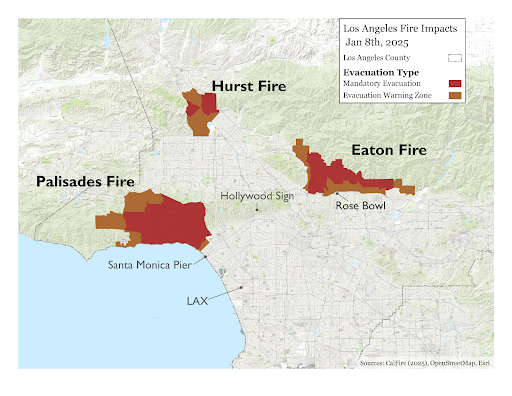Introduction
Since last week, wildfires have swept through various communities in Los Angeles County, leaving destruction in their wake. In addition to the loss of lives and property, these disasters disrupt the livelihoods and economic stability of affected communities. For Latinos, who make up a significant portion of the Los Angeles workforce, these rippling effects are particularly severe. This brief summarizes the potential workforce dynamics across three major fire evacuation zones in Los Angeles County on January 8th, 2025, at 2 pm, emphasizing the significant representation of Latinos. The findings underscore the pressing need for equitable disaster response and recovery strategies that ensure the most affected communities receive the resources and support they need to rebuild and thrive. Map 1 illustrates the evacuation and warning zones for the three wildfire sites. The Palisades Fire, originating in Pacific Palisades, spread from coastal communities to inland areas, prompting widespread evacuations and tragic loss of life. The Eaton Fire, located in Eaton Canyon near Pasadena and Altadena, has caused significant structural damage and fatalities. The Hurst Fire in Sylmar threatens communities in the northeast San Fernando Valley. Other fires have also plagued Los Angeles; however, we do not capture these due to the timing of data collection.
Map 1. Evacuation Order & Warning Zones for Eaton, Palisades, and Hurst Fires

Note: The map displays the mandatory evacuation and evacuation warning zones associated with the Eaton, Palisades, and Hurst Fires as of January 8, 2025, at 2:00 pm PST.
Source: CalFire, available online.
Finding 1: At least 35,000 jobs held by Latinos were at risk of temporary or permanent displacement due to the wildfires
Figure 1 provides estimates of the Latino population and workforce across the three major fires. Although Latinos comprise just 23% of the population across the three evacuation zones, they account for 36% of all workers in those areas. The disparity is particularly striking in the Palisades Fire zone, where Latinos hold 34% of jobs despite representing just 7% of the population. Similarly, Latinos account for 33% of residents but 47% of workers in the Hurst Fire zone. The comparable percentages in the Eaton Fire zone are 27% and 35%. The data shows that Latinos are vital to the local workforce, especially in the Palisades Fire zone.Figure 1. Latino representation among residents and jobs in fire evacuation zones
Note: Latinos include those who identify as Hispanic or Latino of any race. The percent of total represents the percentage within each evacuation zone. Evacuation zones include mandatory and warning zones as outlined by CalFire, available online on January 8, 2025, at 2 p.m. PST. Source: Tabulated by authors from the 2020 Decennial Census, 2022 LEHD LODES.
Finding 2: Latino workers face greater economic instability due to limited opportunities for remote work
Latino workers in evacuation zones are more vulnerable to economic disruptions than white workers because they are disproportionately employed in occupations and industries that do not allow for remote work. Figure 2 shows the share of workers 16 and over who work from home in Los Angeles County. While 22% of white workers in Los Angeles County can work from home, only 7% of Latino workers share this option. This disparity underscores the overrepresentation of Latinos in jobs requiring a physical presence, such as service, retail, and manual labor. These roles are particularly susceptible to temporary layoffs during wildfire-related disruptions and, in some cases, permanent job loss if workplaces are damaged or destroyed. The financial disruption is particularly hard on those living paycheck to paycheck.Figure 2. Percentage of workers 16 and over who work from home in Los Angeles County
Note: Latinos include those who identify as Hispanic or Latino of any race. White workers exclude those who identify as Hispanic or Latino. Source: Tabulated by authors from the 2018-2022 5-year ACS PUMS.
